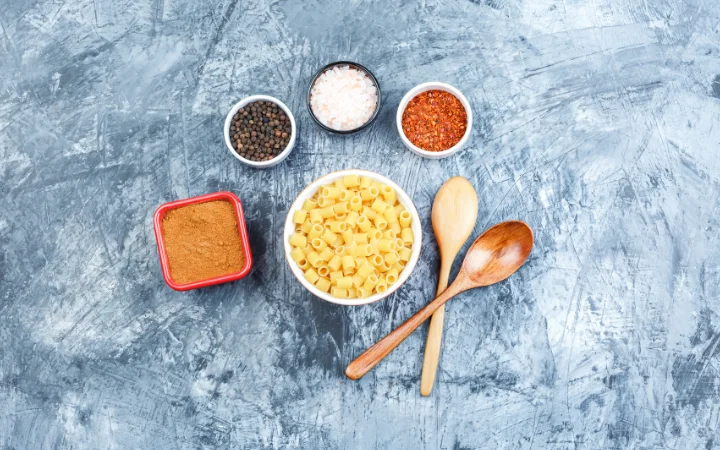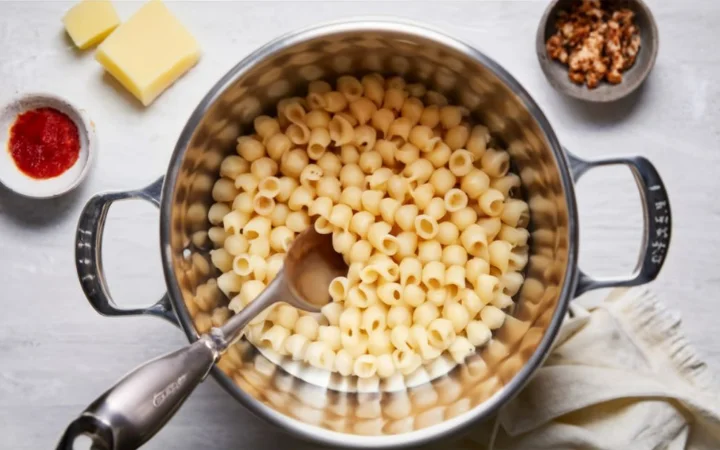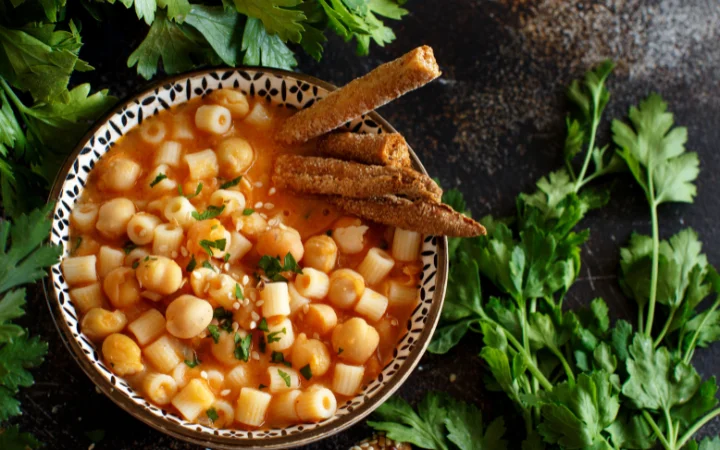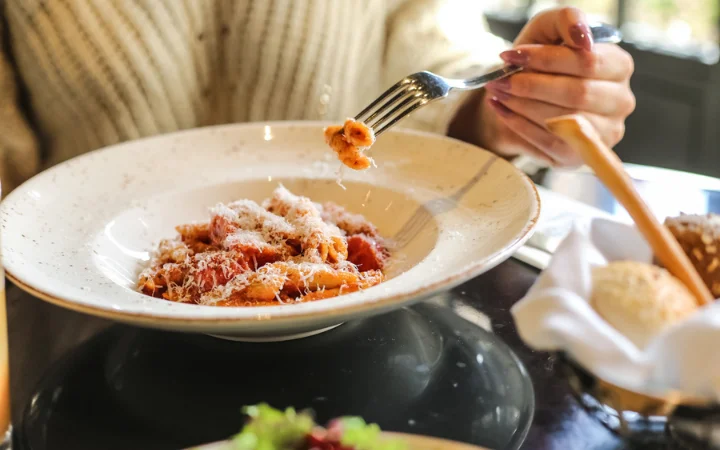In the culinary world, pasta stands as a versatile and beloved ingredient, weaving its way through the fabric of global cuisines with ease and grace. Among its myriad forms, ditalini, a tiny tube-shaped pasta, emerges as a culinary star in its own right. This article embarks on a flavorful journey, exploring the essence of ditalini recipes, from hearty soups to refreshing salads, and diving into the rich tapestry of cooking tips, nutritional insights, and frequently asked questions that surround this delightful pasta. Whether you’re a seasoned chef or a curious foodie, prepare to be inspired by the simplicity and adaptability of ditalini, as we uncover its secrets and celebrate its place in the world of gastronomy.
Introduction to Ditalini Pasta
Ah, ditalini—the unsung hero of the pasta world. This pint-sized pasta might seem unassuming at first glance, but don’t let its size fool you. Ditalini, with its charming tube shape and bite-sized dimensions, is a powerhouse of versatility, ready to elevate your culinary creations from good to unforgettable.
Brief History and Origin
Diving into the origins of ditalini, we find ourselves whisked away to Italy, the birthplace of pasta. Ditalini, translating to ‘little thimbles’ in Italian, boasts a storied history deeply intertwined with Italian cuisine’s evolution. From its initial design to complement soups and salads, ditalini has become a global kitchen staple. For a deeper dive into its fascinating journey, explore more about the history and varieties of ditalini at The Pasta Project.
Characteristics of Ditalini Pasta
What sets ditalini apart, you might wonder? Its diminutive size and tubular shape make it the perfect candidate for soaking up flavors and melding harmoniously with a variety of ingredients. Whether nestled in a brothy soup or tossed in a vibrant salad, ditalini adds a delightful texture and visual appeal to any dish.
Common Uses in Cuisines
From the rustic kitchens of Italy to the bustling streets of international culinary scenes, ditalini finds its way into an array of dishes. In classic Italian minestrone, it mingles with vegetables and beans, absorbing the rich broth and imparting a satisfying chew. In modern pasta salads, it dances with fresh veggies and zesty dressings, proving that good things indeed come in small packages.
So, there you have it—a peek into the world of ditalini pasta. As we continue our journey, keep in mind that this tiny pasta is more than just a food item; it’s a canvas for creativity, a bridge between cultures, and a testament to the joy of cooking. Stay tuned as we delve deeper into the delicious realm of ditalini recipes, uncovering the secrets to making the most out of this delightful pasta.
Popular Ditalini Recipes
Now, let’s dive into the heart of our culinary exploration with some ditalini recipes that are sure to tantalize your taste buds. Each dish showcases ditalini’s unique ability to blend seamlessly with a variety of flavors, creating meals that are both comforting and exciting.
Classic Italian Minestrone with Ditalini
First up, we have the classic Italian minestrone. This hearty soup is a symphony of fresh vegetables, beans, and, of course, ditalini. The pasta’s small size means it cooks quickly and evenly, absorbing the rich flavors of the broth. To make this dish, you’ll start by sautéing onions, carrots, and celery. Then, add in tomatoes, vegetable broth, and your choice of beans. Let it simmer, and then, toss in the ditalini towards the end. Season with salt, pepper, and a sprinkle of Parmesan cheese for that final touch. For an authentic and flavorful minestrone recipe, check out this version at The Mediterranean Dish.
Ditalini Pasta Salad with Passion Fruit Vinaigrette
Next, we have a refreshing ditalini pasta salad with a twist. The passion fruit vinaigrette adds a tropical flair, making this dish a standout at any table. Combine cooked ditalini with diced cucumbers, cherry tomatoes, and red onions. For the vinaigrette, whisk together passion fruit pulp, olive oil, vinegar, and a hint of honey. Drizzle it over the salad, and voilà! You’ve got a vibrant, flavorful dish that’s perfect for summer gatherings.
Mexican Minestrone Chicken Stew
Then, there’s the Mexican minestrone chicken stew, a delightful fusion that brings a spicy kick to the traditional ditalini recipe. Start with browning chicken pieces, and set them aside. In the same pot, cook onions, garlic, and bell peppers until soft. Add diced tomatoes, chicken broth, and a mix of your favorite beans. Return the chicken to the pot, and let it simmer. A few minutes before serving, add the ditalini and a dash of chili powder for that extra zing.
Turkey Fagioli Soup
Lastly, the turkey fagioli soup is a comforting, protein-packed meal that’s perfect for chilly evenings. Begin by cooking ground turkey until it’s no longer pink. Add onions, garlic, carrots, and celery, cooking until tender. Pour in chicken broth, diced tomatoes, and white beans, bringing it to a simmer. The ditalini goes in last, cooking until just tender. Serve with a sprinkle of fresh herbs and Parmesan cheese for a cozy, satisfying bowl of soup. For a heartwarming take on this classic, incorporating both turkey and beans, explore the recipe at Shady Brook Farms.
In each of these recipes, ditalini proves to be the perfect partner, blending effortlessly with a wide range of ingredients. Whether you’re in the mood for something hearty, refreshing, spicy, or comforting, there’s a ditalini recipe out there for you. So, why not give one of these dishes a try? You might just discover your new favorite way to enjoy this versatile pasta.

Cooking Tips and Tricks for Perfect Ditalini Pasta
Now, let’s shift gears and focus on some essential tips and tricks that will ensure your ditalini dishes turn out perfectly every time. After all, even the simplest ingredients can shine with the right techniques. Remember, the key to a perfect ditalini dish lies not only in the pasta itself but also in how it’s prepared and served. For an in-depth guide on making a classic pasta e fagioli, which beautifully incorporates ditalini, head over to Simply Recipes for expert advice and a step-by-step walkthrough.
Choosing the Right Ditalini Pasta
First things first, picking the right ditalini is crucial. Look for pasta made from 100% durum wheat semolina for the best texture and flavor. High-quality ditalini will hold up better during cooking, ensuring that each bite is perfectly al dente.
Cooking Methods for Ditalini
When it comes to cooking ditalini, timing is everything. Start by bringing a large pot of salted water to a boil. Add the pasta and stir occasionally to prevent sticking. Since ditalini is small, it cooks quickly, usually in about 8 to 10 minutes. To achieve that ideal al dente texture, start tasting a couple of minutes before the recommended cooking time. Once done, drain it well but save a bit of the pasta water. This starchy liquid is a secret weapon for adding silkiness to sauces.
Pairing Sauces and Ingredients
Ditalini is incredibly versatile, pairing well with a wide range of sauces and ingredients. For soupy dishes like minestrone, its ability to absorb flavors without becoming mushy is a game-changer. In pasta salads, ditalini complements both creamy and vinaigrette-based dressings, making it a go-to choice for picnics and potlucks. And let’s not forget about casseroles, where ditalini can stand up to baking without losing its texture.
So, there you have it—a few simple yet effective tips to elevate your ditalini cooking game. Remember, the best dishes come from not just following recipes but understanding the hows and whys behind each step. By choosing the right pasta, mastering the cooking process, and pairing it with complementary flavors, you’ll unlock the full potential of ditalini and impress your guests with your pasta prowess.

Health and Nutrition
In the midst of exploring delicious ditalini recipes and mastering cooking techniques, it’s also important to consider the health and nutritional aspects of this beloved pasta. After all, enjoying food is not just about taste but also about nourishing our bodies. Pasta, including ditalini, can be part of a balanced diet when consumed in moderation and paired with the right ingredients. For a deeper understanding of pasta’s place in a healthy diet, explore the insights provided by Healthline on whether pasta is healthy or unhealthy.
Nutritional Benefits of Ditalini Pasta
Ditalini, like most pasta, is primarily made from durum wheat, making it a good source of complex carbohydrates. These carbs provide the body with energy that is released slowly, keeping you fueled for longer periods. Additionally, ditalini contains a modest amount of protein and is low in fat, making it a balanced choice for meal planning.
For those looking to increase their fiber intake, whole wheat ditalini options are available. These not only offer a richer, nuttier flavor but also contribute to better digestive health, thanks to their higher fiber content.
Incorporating Ditalini into a Balanced Diet
Incorporating ditalini into a balanced diet is all about the company it keeps. Pairing this pasta with a variety of vegetables, lean proteins, and healthy fats can turn a simple ditalini dish into a nutritional powerhouse. For instance, a ditalini salad with cherry tomatoes, cucumbers, olives, and a drizzle of olive oil provides vitamins, minerals, and heart-healthy fats.
Moreover, for those with dietary restrictions, gluten-free ditalini made from rice, corn, or quinoa flour is widely available. This ensures that everyone can enjoy the pleasures of pasta, regardless of their dietary needs.
In conclusion, ditalini pasta is not only versatile and delicious but can also be a part of a healthy and balanced diet. By being mindful of the ingredients you pair it with and opting for whole grain or gluten-free versions when necessary, you can enjoy ditalini dishes that are both satisfying and nutritious. So, the next time you’re planning a meal, remember that ditalini offers a world of possibilities, both for your palate and your health.

Frequently Asked Questions
As we’ve journeyed through the world of ditalini pasta, exploring its versatility in recipes and the best practices for cooking it to perfection, it’s natural that you might have some questions. To help you avoid common pitfalls and ensure your pasta dishes are as delicious as possible, we recommend checking out this comprehensive guide on common pasta mistakes to avoid, courtesy of Food Network. This resource is packed with expert advice to tackle those burning questions and elevate your pasta cooking game.
What is ditalini pasta used for?
Ditalini pasta is primarily used in soups and salads due to its small, tube-like shape that makes it perfect for spooning up in brothy dishes or mixing with a variety of ingredients in cold salads. It’s also popular in pasta bakes and casseroles, where its size allows it to blend well with other components.
Can ditalini pasta be substituted in recipes?
Absolutely! If you find yourself without ditalini or simply want to try something different, there are several suitable substitutes. Pastas like orzo, macaroni, and even broken pieces of spaghetti or linguine can serve as alternatives, depending on the dish. The key is to match the pasta’s cooking time and ability to integrate with the other ingredients in your recipe.
How do you cook ditalini pasta perfectly?
To cook ditalini pasta perfectly, bring a large pot of salted water to a boil. Add the pasta and stir occasionally to prevent it from sticking together. Cook according to the package instructions, usually between 8 to 10 minutes, until it’s al dente. Remember, tasting a piece of pasta a minute or two before the suggested cooking time can help you achieve that perfect texture.
Are there gluten-free ditalini pasta options?
Yes, for those who follow a gluten-free diet, there are several gluten-free ditalini options available on the market. These are typically made from alternative flours such as rice, corn, quinoa, or a blend of gluten-free grains. These alternatives offer the same delightful experience as traditional ditalini, allowing everyone to enjoy a variety of pasta dishes.
With these questions answered, we hope you feel more confident and inspired to incorporate ditalini pasta into your cooking repertoire. Whether you’re whipping up a comforting soup, a refreshing salad, or a hearty casserole, ditalini offers endless possibilities for delicious and satisfying meals. So, go ahead, get creative in the kitchen, and let ditalini pasta be the star of your next culinary creation!
Conclusion and Final Thoughts
As we conclude our journey with ditalini pasta, it’s evident this small pasta plays a big role in culinary arts. From its origins to its role in various dishes, ditalini has shown versatility and charm. We’ve explored tasty recipes, cooking tips, and health insights. Plus, we’ve answered common questions, aiming to inspire and inform.
In sum, ditalini is more than just pasta. It’s a key ingredient for creative, nutritious meals. It pairs well with many ingredients, fitting various diets. So, next time you cook, consider ditalini. Let it inspire dishes that bring joy and health to your table. Here’s to happy cooking with ditalini!

